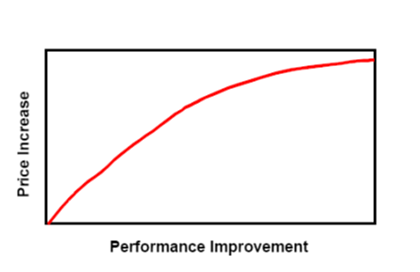PERFORMANCE VERSUS PRICE
This post is based on a section from J. Bicerano, A Practical Guide to Polymeric Compatibilizers for Polymer Blends, Composites and Laminates, SpecialChem, December 2005. The two figures shown in this post are reproduced from this article.
As an empirical rule, if a polymeric product remains a commodity material competing for use in commodity-type applications, the price that the average customer is willing to pay will only increase proportionally to the logarithm of the improvement in its performance:
Price2 ≈ Price1 + cּ ln(Performance2/Performance1)
In this equation, Price2>Price1, Performance2>Performance1 are the corresponding performance levels, “c” is a positive proportionality constant, and “ln” is the natural logarithm. See Figure 1 for a schematic illustration. This equation can be generalized readily to more complex cases where the overall “desirability” for a particular application depends on several performance criteria that have different levels of relative importance.

Figure 1. Schematic illustration of the "commodity trap"; namely, the empirical rule that, if a polymeric product remains a commodity material competing for use in commodity-type applications, then the price that the average customer is willing to pay for this material will only increase proportionally to the logarithm of the improvement in its performance
The main implication of this equation is that whatever is done to improve the performance of a polymer (blending, incorporation of fillers, lamination, processing in a different way, etc.) must not be allowed to increase by much the sales price required to make a profit if its improved performance remains in the commodity product range. We will refer to this fundamental limitation on the price that the market will be willing to pay for a commodity polymer as the “commodity trap”. It is only if the performance can be increased sufficiently to make the material competitive for higher-valued specialty applications (thus escaping the “commodity trap”) that a significant price increase can be allowed. A few examples will be provided below.
Car manufacturers are usually reluctant to pay a large price premium (sometimes any price premium at all) for the improved performance of parts fabricated from engineering plastics unless they are producing extremely expensive (and prestigious) vehicles such as Rolls Royce or Ferrari. More generally, automotive consumers are often willing to pay for features that are noticeable by their five senses (such as more attractive fascia, more comfortable controls, high- intensity discharge headlights, advanced sound systems and a quiet interior), as well as for major enhancements in vehicle quality and safety. On the other hand, if the effects of a new feature or component of a vehicle cannot be “sensed” by the consumer and if it also has no implications in terms of significantly enhanced real or perceived quality and safety, consumers will not be willing to pay any price premium for it and cost will be the overriding consideration.
If an inexpensive polymer (such as a polyolefin) can be modified so that its properties become competitive with those of an expensive engineering plastic, it can escape the “commodity trap” since new potential applications become possible for it. It can then command a significant price premium over the “ordinary” (commodity) grades of the polymer. It must, however, still remain cheaper than the engineering plastic which it displaces in a higher-valued application. See the path CP1⇨CP2 in Figure 2 for a schematic illustration.
If an expensive engineering polymer that far exceeds the requirements of an application can be combined with much cheaper ingredients to provide a less expensive polymer blend or composite that can still perform acceptably in the same application, the market will welcome such a blend or composite. See the path EP1⇨EP2 Figure 2 for a schematic illustration.

Figure 2. Schematic illustration of two situations where blending and/or compounding are especially attractive from a commercial viewpoint. The thick vertical brown line represents the minimum acceptable performance required to qualify a material for a certain application. The ellipses represent regions on the "price-performance plane". EP1 is an expensive engineering polymer that far exceeds the performance requirements of the application. EP2 is a cheaper blend or composite of EP1 with less expensive ingredients, still exceeding the minimum performance requirements. CP1 is a commodity polymer that does not meet the performance requirements of the application. CP2 is a blend or composite of CP1 that exceeds the minimum performance requirements and can thus be sold at substantially higher price.
